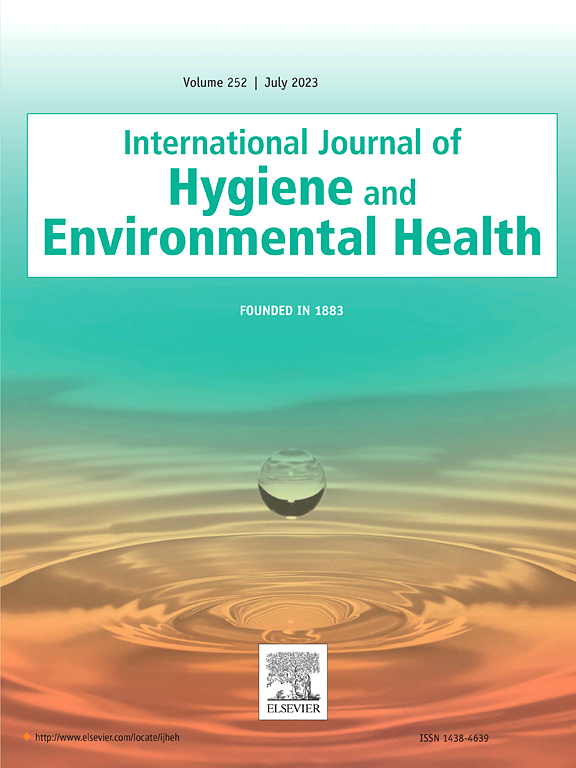Environmental, climatic, socio-economic factors and non-pharmacological interventions: A comprehensive four-domain risk assessment of COVID-19 hospitalization and death in Northern Italy
IF 4.5
2区 医学
Q1 INFECTIOUS DISEASES
International journal of hygiene and environmental health
Pub Date : 2024-10-03
DOI:10.1016/j.ijheh.2024.114471
引用次数: 0
Abstract
Introduction
Up to now, studies on environmental, climatic, socio-economic factors, and non-pharmacological interventions (NPI) show diverse associations, often contrasting, with COVID-19 spread or severity. Most studies used large-scale, aggregated data, with limited adjustment for individual factors, most of them focused on viral spread than severe outcomes. Moreover, evidence simultaneously evaluating variables belonging to different exposure domains is scarce, and none analysing their collective impact on an individual level.
Methods
Our population-based retrospective cohort study aimed to assess the comprehensive role played by exposure variables belonging to four different domains, environmental, climatic, socio-economic, and non-pharmacological interventions (NPI), on individual COVID-19-related risk of hospitalization and death, analysing data from all patients (no. 68472) tested positive to a SARS-CoV-2 swab in Modena Province (Northern Italy) between February 2020 and August 2021.
Using adjusted Cox proportional hazard models, we estimated the risk of severe COVID-19 outcomes, investigating dose-response relationships through restricted cubic spline modelling for hazard ratios.
Results
Several significant associations emerged: long-term exposure to air pollutants (NO2, PM10, PM2.5) was linked to hospitalization risk in a complex way and showed an increased risk for death; while humidity was inversely associated; temperature showed a U-shaped risk; wind speed showed a linear association with both outcomes. Precipitation increased hospitalization risk but decreased mortality. Socio-economic and NPI indices showed clear linear associations, respectively negative and positive, with both outcomes.
Conclusions
Our findings offer insights for evidence-based policy decisions, improving precision healthcare practices, and safeguarding public health in future pandemics. Refinement of pandemic response plans by healthcare authorities could benefit significantly.
环境、气候、社会经济因素和非药物干预措施:意大利北部 COVID-19 住院和死亡的四领域综合风险评估。
导言:迄今为止,有关环境、气候、社会经济因素和非药物干预措施(NPI)的研究显示,COVID-19 的传播或严重程度与多种因素有关,而且往往形成鲜明对比。大多数研究使用的是大规模的综合数据,对个体因素的调整有限,其中大多数研究侧重于病毒传播而非严重后果。此外,同时评估属于不同暴露领域的变量的证据很少,没有一项研究分析了这些变量对个体的集体影响:我们基于人群的回顾性队列研究旨在评估属于环境、气候、社会经济和非药物干预(NPI)四个不同领域的暴露变量对与 COVID-19 相关的个人住院和死亡风险的综合作用,该研究分析了 2020 年 2 月至 2021 年 8 月期间摩德纳省(意大利北部)所有经 SARS-CoV-2 拭子检测呈阳性的患者(编号:68472)的数据。我们使用调整后的 Cox 比例危险模型估算了 COVID-19 严重后果的风险,并通过限制性立方样条模型对危险比的剂量-反应关系进行了研究:出现了几种重要的关联:长期暴露于空气污染物(二氧化氮、可吸入颗粒物 10、可吸入颗粒物 2.5)以复杂的方式与住院风险相关,并显示出死亡风险增加;而湿度与之呈反比;温度显示出 U 型风险;风速与两种结果均呈线性相关。降水增加了住院风险,但降低了死亡率。社会经济指数和NPI指数与两种结果均呈明显的线性关系,分别为负相关和正相关:我们的研究结果为循证决策、改进精准医疗实践以及在未来大流行中保障公共卫生提供了启示。医疗机构对大流行病应对计划的改进也将受益匪浅。
本文章由计算机程序翻译,如有差异,请以英文原文为准。
求助全文
约1分钟内获得全文
求助全文
来源期刊
CiteScore
11.50
自引率
5.00%
发文量
151
审稿时长
22 days
期刊介绍:
The International Journal of Hygiene and Environmental Health serves as a multidisciplinary forum for original reports on exposure assessment and the reactions to and consequences of human exposure to the biological, chemical, and physical environment. Research reports, short communications, reviews, scientific comments, technical notes, and editorials will be peer-reviewed before acceptance for publication. Priority will be given to articles on epidemiological aspects of environmental toxicology, health risk assessments, susceptible (sub) populations, sanitation and clean water, human biomonitoring, environmental medicine, and public health aspects of exposure-related outcomes.

 求助内容:
求助内容: 应助结果提醒方式:
应助结果提醒方式:


